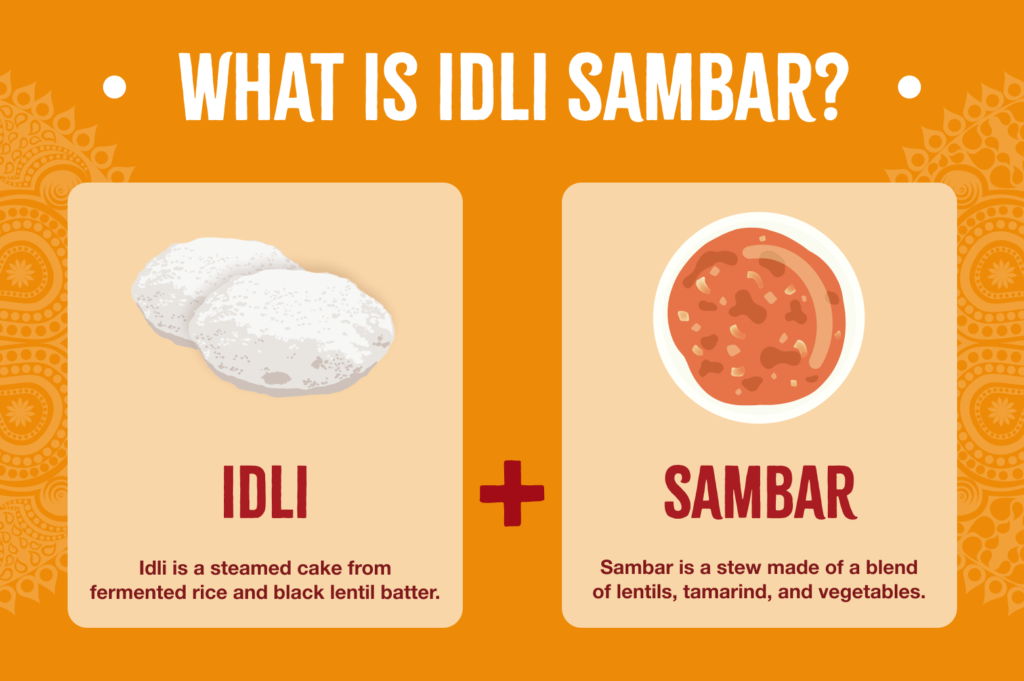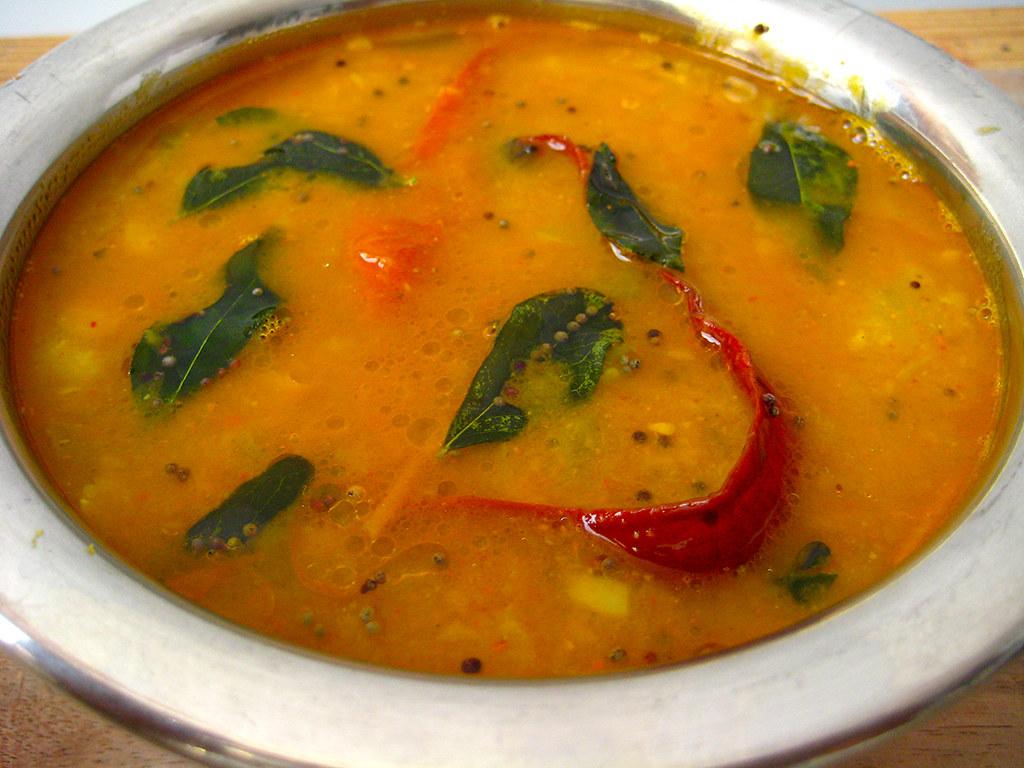What is Idli Sambar?
Hello, dear food lovers! We’re thrilled to introduce you to one of our favorite dishes from the southern parts of India: Idli Sambar.
If you’re a fan of Indian cuisine or just curious about trying something new and mouthwateringly delicious, you’re in for a treat. Let’s dive right in!
Idli Sambar in South Indian Cuisine
South Indian cuisine, with its rich tapestry of flavors and traditions, offers a delightful gastronomic experience, and at the heart of this culinary treasure is the iconic Idli Sambar. This dish is more than just food; it reflects the region’s culture, history, and way of life.
Idli Sambar combines two of South India’s most beloved staples. The region, known for its extensive use of rice and lentils, has made the most of these ingredients in creating this dish.
While South Indian cuisine offers many delicacies, from crispy dosas to spicy curries, Idli Sambar stands out for its simplicity yet profound flavors.
It’s a testament to the culinary wisdom of the region, where ingredients transform into nutritious and flavorful dishes.

What is Idli?
Idli is a soft, fluffy, steamed cake from fermented rice and black lentil batter. It has a subtle, mildly tangy taste thanks to the fermentation process.
Idlis are often enjoyed as a breakfast dish in South India, but they’ve gained popularity worldwide for a good reason. They’re not only delicious but also super healthy, being low in calories and rich in essential nutrients.
The Origin and Evolution of Idli
Idli, often described as the breakfast of champions in the South, has historical roots that might surprise you. Ancient Tamil literature from as early as the 8th century makes mention of a dish that sounds strikingly similar to idli.
However, the modern idli recipe, which utilizes fermented rice and black lentil batter, likely has Indonesian origins, thanks to the ancient trade relations between the Southeast Asian country and South India.

What is Sambar?
Sambar, with its warm and inviting aroma, is an essential counterpart to idli. It is a hearty, aromatic stew that holds a prime spot in South Indian kitchens.
At its core, Sambar is made from boiled and mashed lentils (typically pigeon peas or toor dal) that serve as the base. What gives Sambar its distinct tangy flavor is tamarind pulp, which is soaked and then mixed into the stew.
A Delectable Blend of Ingredients
Sambar is a harmonious blend of lentils, tamarind, and vegetables. The base of sambar is made from pigeon peas (known as toor dal) that are boiled, mashed, and then simmered in a tamarind broth.
The choice of vegetables varies, but it often includes drumsticks, pumpkin, okra, tomatoes, and eggplant. The dish is then seasoned with a unique mix of spices, including sambar powder, a blend of roasted lentils, dried red chilies, fenugreek seeds, coriander seeds, and other aromatic herbs.
The History of Sambar
The origins of sambar are rooted in South Indian folklore. One popular story suggests that it was first made by the Marathi King Sambhaji when he tried to make a dish with kokum (a sour fruit) in the absence of tamarind.
The dish he accidentally created resembled today’s sambar. Whatever its origin, sambar has become a staple dish in South Indian households and is cherished for its hearty and comforting nature.
Idli Sambar: A Match Made in Culinary Heaven
When idli and sambar come together, the result is nothing short of magical. With their mild flavor, the spongy idlis ideally soak up the tangy and spicy goodness of the sambar, creating a balanced and fulfilling meal. This combination is not only a favorite for breakfast but is also enjoyed during lunch, dinner, or even as a snack.
The idli absorbs the rich flavors of the sambar, ensuring each bite is a burst of taste and texture. To enhance the experience, the duo is often served with coconut chutney and a dollop of ghee or clarified butter.
Pairings and Accompaniments
While Idli Sambar is a complete meal in itself, there are a plethora of side dishes that elevate this culinary experience.
With its tangy and spicy notes, tomato chutney complements the mild flavor of idli beautifully. For those who prefer a hint of freshness, mint chutney, with its vibrant green hue and refreshing taste, is a perfect match.
Then there’s the aromatic world of podis (flavorful dry spice blends) or spice powders. These dry powders, made by grinding various spices and lentils, are mixed with oil or ghee and served alongside idli. Depending on the ingredients used, they add an extra layer of flavor, ranging from fiery to earthy.
Mastering the Art: Cooking Tips for the Perfect Idli Sambar
Achieving the perfect Idli Sambar requires patience, technique, and love. Here are some pro tips to help you master this dish:
For Fluffy Idlis
The secret to soft idlis lies in the batter. Ensure your batter is fermented well, especially in colder regions where you might need to let it ferment a bit longer. The consistency should be thick yet pourable. Before steaming, a pinch of baking soda can be added to ensure extra fluffiness.
Sambar Consistency
The ideal sambar is neither too thick nor too watery. A good rule of thumb is when your lentils are cooked; they should be easily mashable but retain some texture.
Sequence Matters
When making sambar, always add the vegetables according to their cooking time. Start with harder vegetables like drumsticks and radishes, and add softer ones like tomatoes towards the end.
Fresh Spices
Always opt for freshly ground sambar powder if possible. It elevates the dish’s flavor profile immensely compared to store-bought versions.
Explore Beyond Idli Sambar with Sulkhi’s
Idli Sambar is a culinary delight that celebrates the essence of South India. At Sukhi’s, we take immense pride in sharing this rich tradition with you. But our journey doesn’t stop there.
Dive into our frozen Chicken Tikka Masala or savor the depth of our Chicken Vindaloo. If you want to try something unique, our fusion recipes are easy to make and waiting to tantalize your taste buds. And for more flavors, inspirations, and stories, make sure to explore our blog.
Here’s to a flavorful adventure with Sukhi’s!
No comments yet.